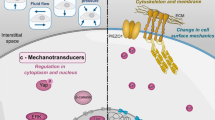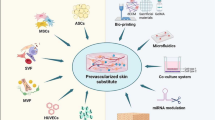We studied angiogenin production by human macrophages and evaluated the role of this factor in the macrophage-mediated regulation of fibroblasts. All macrophage subtypes, and especially the efferocytosis-polarized macrophages, M2(LS), actively produced angiogenin. Exogenous recombinant angiogenin dose-dependently enhanced the proliferation and differentiation of dermal fibroblasts. The addition of the angiogenin inhibitor to fibroblasts cultures suppressed the stimulating effect of exogenous angiogenin or M2(LS) conditioned media. These findings indicate the involvement of angiogenin in the macrophage-mediated paracrine regulation of skin fibroblasts.
Similar content being viewed by others
References
Witherel CE, Abebayehu D, Barker TH, Spiller KL. Macrophage and fibroblast interactions in biomaterial-mediated fibrosis. Adv. Healthc Mater. 2019;8(4):e1801451. doi: https://doi.org/10.1002/adhm.201801451
Pakshir P, Hinz B. The big five in fibrosis: Macrophages, myofibroblasts, matrix, mechanics, and miscommunication. Matrix Biol. 2018;68-69:81-93. doi: https://doi.org/10.1016/j.matbio.2018.01.019
Poto R, Loffredo S, Palestra F, Marone G, Patella V, Varricchi G. Angiogenesis, lymphangiogenesis, and inflammation in Chronic Obstructive Pulmonary Disease (COPD): few certainties and many outstanding questions. Cells. 2022;11(10):1720. doi: https://doi.org/10.3390/cells11101720
Sheng J, Xu Z. Three decades of research on angiogenin: a review and perspective. Acta Biochim. Biophys. Sin. (Shanghai). 2016;48(5):399-410. doi: https://doi.org/10.1093/abbs/gmv131
Lee SH, Kim KW, Min KM, Kim KW, Chang SI, Kim JC. Angiogenin reduces immune inflammation via inhibition of TANK-binding kinase 1 expression in human corneal fibroblast cells. Mediators Inflamm. 2014;2014:861435. doi: https://doi.org/10.1155/2014/861435
Yurina NV, Ageeva TA, Goryachkin AM, Varaksin NA, Ryabicheva TG, Ostanin AA, Chernykh ER, Romashchenko AV, Proskurina AS, Bogachev S, Purtov AV. Effects of recombinant angiogenin on collagen fiber formation and angiogenesis in the dermis of Wistar rats. Clin. Cosmet. Investig. Dermatol. 2021;14:187-196. doi: https://doi.org/10.2147/CCID.S294825
Cucci LM, Satriano C, Marzo T, La Mendola D. Angiogenin and copper crossing in wound healing. Int. J. Mol. Sci. 2021;22(19):10704. doi: https://doi.org/10.3390/ijms221910704
Maksimova AA, Shevela EYa, Sakhno LV, Tikhonova MA, Ostanin AA, Chernykh ER. Influence of secretome of different functional phenotypes of macrophages on proliferation, differentiation, and collagen-producing activity of dermal fibroblasts in vitro. Bull. Exp. Biol. Med. 2021;171(1):64-68. doi: https://doi.org/10.1007/s10517-021-05170-y
Singh K, Maity P, Koroma AK, Basu A, Pandey RK, Vander Beken S, Haas P, Krug L, Hainzl A, Sindrilaru A, Pfeiffer C, Wlaschek M, Frank NY, Frank MH, Ganss C, Bánvölgyi A, Wikonkál N, Eming S, Pastar I, Tomic-Canic M, Kluth MA, Scharffetter-Kochanek K. Angiogenin released from ABCB5+ stromal precursors improves healing of diabetic wounds by promoting angiogenesis. J. Invest. Dermatol. 2022;142(6):1725-1736.e10. doi: https://doi.org/10.1016/j.jid.2021.10.026
D’Urso M, Kurniawan NA. Mechanical and physical regulation of fibroblast-myofibroblast transition: from cellular mechanoresponse to tissue pathology. Front. Bioeng. Biotechnol. 2020;8:609653. doi: https://doi.org/10.3389/fbioe.2020.609653
Hu GF. Neomycin inhibits angiogenin-induced angiogenesis. Proc. Natl Acad. Sci. USA. 1998;95(17):9791-9795. doi: https://doi.org/10.1073/pnas.95.17.9791
Kim KW, Park SH, Wee SW, Kim JC. Overexpression of angiogenin in pterygium body fibroblasts and its association with proliferative potency. Invest. Ophthalmol. Vis. Sci. 2013;54(9):6355-6362. doi: https://doi.org/10.1167/iovs.13-12141
Jones ML, Ewing CM, Isaacsa WB, Getzenberg RH. Prostate cancer-derived angiogenin stimulates the invasion of prostate fibroblasts. J. Cell. Mol. Med. 2012;16(1):193-201. doi: https://doi.org/10.1111/j.1582-4934.2011.01283.x
Pan SC, Lee CH, Chen CL, Fang WY, Wu LW. Angiogenin attenuates scar formation in burn patients by reducing fibroblast proliferation and Transforming Growth Factor β1 secretion. Ann. Plast. Surg. 2018;80(2S, Suppl. 1):S79-S83. doi: https://doi.org/10.1097/SAP.0000000000001306
Author information
Authors and Affiliations
Corresponding author
Additional information
Translated from Byulleten’ Eksperimental’noi Biologii i Meditsiny, Vol. 175, No. 5, pp. 597-601, May, 2023
Rights and permissions
Springer Nature or its licensor (e.g. a society or other partner) holds exclusive rights to this article under a publishing agreement with the author(s) or other rightsholder(s); author self-archiving of the accepted manuscript version of this article is solely governed by the terms of such publishing agreement and applicable law.
About this article
Cite this article
Maksimova, A.A., Shevela, E.Y., Tikhonova, M.A. et al. Angiogenin as a Possible Mediator of Macrophage-Mediated Regulation of Fibroblast Functions. Bull Exp Biol Med 175, 658–661 (2023). https://doi.org/10.1007/s10517-023-05921-z
Received:
Published:
Issue Date:
DOI: https://doi.org/10.1007/s10517-023-05921-z




